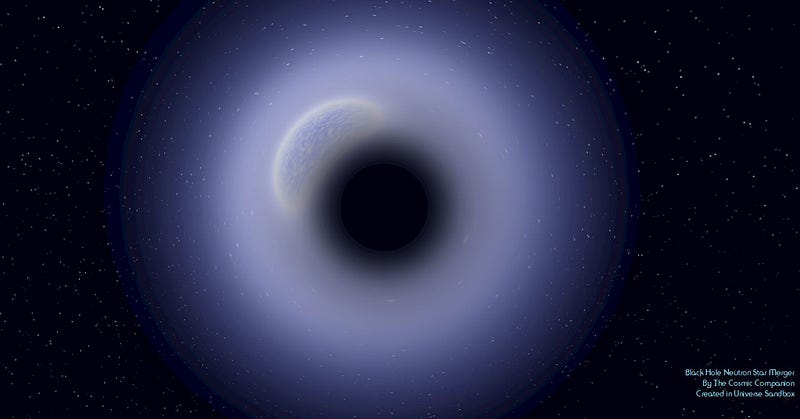Unraveling the Cosmic Dance: Black Holes and Neutron Stars
Written on
Chapter 1: Understanding Gravitational Waves
Black holes consume neutron stars, generating gravitational waves that carry the stories of their collisions across the universe.

When a neutron star collides with a black hole, the warping of spacetime distorts light in the vicinity, while gravitational waves from the event propagate through the universe at light speed.
For over a billion years, these subtle ripples have traversed the cosmos, encoding the history of monumental collisions that occurred when multicellular life was emerging on Earth. Neutron stars, known for their extreme density, are among the most compact stellar remnants; just a thimbleful of their material would outweigh Mount Everest. In contrast, black holes represent the densest known regions in space.
While neutron star binaries have been observed for many years through electromagnetic signals, the first confirmed black hole binary was only identified in 2015 via gravitational wave analysis. Recently, however, astronomers have made groundbreaking discoveries regarding neutron star-black hole (NSBH) systems.
Section 1.1: A Cosmic Mystery Revealed
Astronomers have previously recorded neutron star collisions and black hole mergers, but the observation of black holes consuming neutron stars marks a significant milestone. The evidence of two such colossal events has recently come to light.
A Murder Mystery a Billion Years in the Making
On January 5, 2020, the Laser Interferometer Gravitational-Wave Observatory (LIGO) in the U.S. and the Virgo detector in Italy detected unusual gravitational waves. Remarkably, a similar signal appeared just ten days later.
The analysis of these events, designated GW200105 and GW200115, indicated they were the final moments of neutron stars being engulfed by black holes.
“The prevailing theory suggests that both objects in each binary system were once part of a larger stellar pair. After exhausting their nuclear fuel, they underwent supernova explosions, resulting in a neutron star and a black hole. As they spiraled closer over time due to gravitational-wave energy loss, they ultimately collided. LIGO and Virgo captured the last seconds leading to these dramatic events,” explains Salvatore Vitale, a physicist at MIT and member of the Kavli Institute for Astrophysics and Space Research.
Over the course of a year, astronomers reconstructed the narrative of these ancient cosmic encounters. This saga began a billion years ago when a neutron star, 50% more massive than our Sun, met its end in a collision with a black hole six times the Sun's mass. The gravitational waves from this event were recorded on January 15, 2020, classified as GW200115.
Approximately 100 million years after this initial event, another neutron star, with a mass of 1.9 solar masses, collided with a black hole nine times more massive than the Sun. This second event was recorded on Earth and named GW200105.
In both instances, it is likely that the neutron stars were completely consumed by their monstrous counterparts.
Section 1.2: Riding the Gravitational Waves
“Black holes are the alluring dragons of the universe, seemingly serene yet harboring violent cores, exuding a mysterious aura that draws everything near, consuming all who venture too close,” says Robert Coover in A Child Again.
Gravitational waves, which were first predicted by Albert Einstein's General Theory of Relativity, were finally detected in 2015, leading to a Nobel Prize in Physics in 2017. Since then, astronomers have identified over 50 pairs of binary systems, including those comprising neutron stars and black holes.
With the discovery of NSBH mergers outside our galaxy, astronomers can begin to understand the prevalence and merging frequency of these systems, as well as the reasons behind the lack of observable examples within the Milky Way.
The first event, GW200105, produced a robust signal detected by LIGO Livingston and Virgo, though not as distinctly by LIGO Hanford, which was offline. As a result, the collision's exact location can only be estimated within an area 34,000 times larger than the full Moon.
In contrast, GW200115, detected ten days later, was recorded by all three detectors, allowing astronomers to narrow its location down to a region about 3,000 times larger than the full Moon.
“In January 2020, the LIGO-Virgo network detected gravitational wave signals from two compact binaries, consistent with neutron star-black hole systems. These represent the first definitive observations of NSBH binaries via any observational means,” researchers note in The Astrophysical Journal Letters.
News of these findings quickly circulated within the astronomical community. However, optical observations of the region yielded no visible signs of the events.
Researchers believe the black holes involved in these collisions were sufficiently massive to devour the neutron stars entirely before any significant electromagnetic radiation could be produced.
While the LIGO-Virgo network may have detected black holes consuming neutron stars in earlier events in 2019, those gravitational wave signals may have stemmed from alternative sources, including detector noise.
Current analyses suggest that an NSBH merger occurs roughly once a month within a billion light years of Earth.
With the addition of the new KAGRA detector in Japan to the LIGO-Virgo network, scientists anticipate that their next observational run, beginning in the summer of 2022, could reveal instances of black holes consuming neutron stars on a daily basis.
James Maynard is the founder and publisher of The Cosmic Companion, currently residing in Tucson with his wife, Nicole, and their cat, Max.
Did you enjoy this article? Join us at The Cosmic Companion Network for podcasts, weekly video content, newsletters, and news briefings on Amazon Alexa!